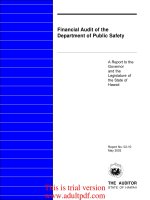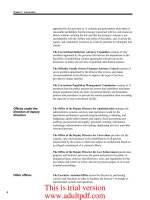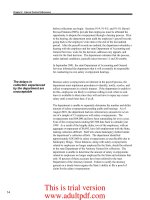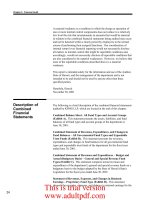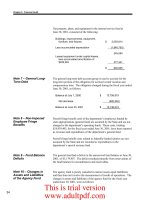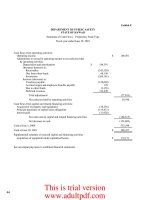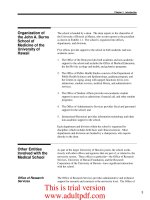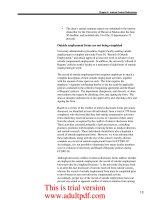Financial Audit of the John A. Burns School of Medicine of the University of Hawaii_part4 potx
Bạn đang xem bản rút gọn của tài liệu. Xem và tải ngay bản đầy đủ của tài liệu tại đây (43.41 KB, 10 trang )
23
Chapter 3: Financial Audit
The school uses the specific identification method to record its
allowance for doubtful accounts.
Prepaid Expenses
Prepaid expenses are amounts paid to vendors or suppliers as of the
fiscal year-end prior to receipt of the associated goods or services.
Investments
Investments of the school consist primarily of endowment investments
that are stated at fair value, as determined by quoted market prices, or
amounts determined by management if quoted market prices are not
available. The net change in the fair value of investments is recognized
as a component of investment income or loss.
Investments of the school’s endowment funds are combined in
investment pools with the university and foundation, unless required by
the donor to be separately invested. Individual endowments subscribe to
or dispose of units in the pools on the basis of a per unit valuation of the
pool fair value. Gains or losses on sales of investments are retained or
absorbed by the endowment principal. Cost of securities sold is
determined using the first-in, first-out method.
The Board of Regents of the university and the Board of Directors of the
foundation (collectively, the “boards”) are responsible for management
of the school’s endowment investments. The boards establish
investment goals and comprehensive guidelines to ensure the
preservation of capital and adequate growth and income. The boards and
appointed investment managers perform regular monitoring of
investment performance. Title to investment securities is vested in the
name of the Securities and Exchange Commission registered brokerage
firms in New York representing the various investment managers of the
university and the foundation.
The university’s and foundation’s policies provide for the distribution to
the school of up to 5 percent of the preceding year’s endowment fair
value. If a donor has not provided specific instructions, state law permits
the boards to authorize for expenditure the net appreciation of the
investments of the endowment funds. Any net appreciation spent is
required to be used for the purposes for which the endowment was
established.
Capital Assets
Capital assets are recorded at cost on the date of acquisition, or if
donated, at appraised value on the date of donation. The school’s policy
is to capitalize tangible, non-expendable personal property having an
This is trial version
www.adultpdf.com
24
Chapter 3: Financial Audit
estimated useful life of more than one year and an acquisition cost of
$5,000 or more per item. Items with acquisition costs under $5,000 are
reflected as equipment expenses on the statement of revenues, expenses,
and changes in net assets. Depreciation on the school’s capital assets is
computed using the straight-line method over the estimated useful lives
of the assets. The school’s capital assets are mainly comprised of
furniture, fixtures, and equipment with useful lives ranging from three to
ten years. Capital assets retired or otherwise disposed of are removed
from the appropriate asset and related accumulated depreciation
accounts. Gains and losses on disposals are reflected as non-operating
income or expense.
Certain capital assets held under capital lease are amortized using the
straight-line method over the lease term, and the related obligations are
reported as liabilities in the statement of net assets. Lease amortization
is included in depreciation expense.
Land and buildings on which school facilities are located and related
infrastructure assets are not reflected in the financial statements of the
school, but are reported in the university’s financial statements.
Accounts Payable
Accounts payable represent the cost of goods or services received that
have not been paid for as of year-end.
Deferred Revenues
Deferred revenues are reported as liabilities on the statement of net
assets and include amounts primarily received for grants and contracts
that have not yet been earned as of year-end.
Due to University of Hawaii
Amounts due to the university are comprised of advances made by the
university to finance the cost of the school’s extramurally sponsored
projects for which funds are received from sponsoring agencies on a cost
reimbursement basis. Pay down of this balance is generally recorded
simultaneously with the receipt of the school’s outstanding accounts
receivable from sponsoring agencies.
Net Assets
The school’s net assets are classified as follows:
Invested in Capital Assets, Net of Related Debt
This component of net assets represents the school’s total investment in
capital assets, net of accumulated depreciation and outstanding debt
obligations related to those capital assets.
This is trial version
www.adultpdf.com
25
Chapter 3: Financial Audit
Restricted Net Assets – Nonexpendable
Nonexpendable restricted net assets include endowments and similar
type assets that are subject to externally imposed constraints and
required to be maintained in perpetuity.
Restricted Net Assets – Expendable
Expendable restricted net assets include resources whose use is legally or
contractually subject to externally imposed constraints.
Unrestricted Net Assets
Unrestricted net assets represent all other net assets not classified as
restricted or invested in capital assets. These resources are derived
primarily from student tuition and fees, state appropriations, and gifts.
When an expense is incurred for purposes for which both restricted and
unrestricted net assets are available, resources are generally applied
proportionate to the benefit realized. For instances in which such a
determination is not feasible or if there are cost compliance issues,
unrestricted resources are applied first.
Internal Activities
All amounts and account balances resulting from activities occurring
among the school, RCUH, foundation, and university have been
eliminated from the accompanying financial statements.
Management’s Estimates
The preparation of financial statements in conformity with accounting
principles generally accepted in the United States of America requires
management to make estimates and assumptions that affect the reported
amounts of assets and liabilities and disclosure of contingent assets and
liabilities at the date of the financial statements and the reported amounts
of revenues and expenses during the reporting period. Actual results
could differ from those estimates.
All school cash and cash equivalents are held either by the State
Treasury or pooled with other university, foundation, or RCUH cash
balances.
At June 30, 2002, information related to the insurance and collateral of
funds deposited with the State Treasury was not available, since such
information is determined on a statewide basis and not for individual
departments. Cash deposits with the State Treasury are either federally
insured or collateralized with obligations of the state or U.S.
government. All securities pledged as collateral are held either by the
State Treasury or by the State’s fiscal agents in the name of the State.
Note 2 - Cash and Cash
Equivalents
This is trial version
www.adultpdf.com
26
Chapter 3: Financial Audit
School cash balances held by the university are pooled with other
university funds and are either federally insured or covered by collateral
held by the state director of finance in the name of the university.
School cash balances held by the foundation and RCUH are also pooled
with their other cash balances and amounts in excess of federally insured
limits are uncollateralized. The school’s cash and cash equivalents at
June 30, 2002 are held as follows:
At June 30, 2002, the school held cash amounts of $7,270,179 that were
subject to externally imposed purpose restrictions and are reported on the
statement of net assets as restricted cash and cash equivalents.
The composition of accounts receivable at June 30, 2002 is summarized
as follows:
The school operates the state’s Hyperbaric Treatment Center out of a
local hospital. At June 30, 2002, $770,554 of outstanding Hyperbaric
Treatment Center receivables due from patients and third party insurance
providers were included in nongovernmental accounts receivable;
$556,687 of this balance has been outstanding for more than 180 days
and is also included in the allowance for doubtful accounts. The
school’s total bad debt expense for FY2001-02 of $159,974 was due to
the increase in the balance of the allowance for doubtful Hyperbaric
Treatment Center accounts receivable from the prior year.
Student loans receivable is reported separately on the statement of net
assets in the amount of $55,110, net of an allowance for doubtful
accounts of $1,050 as of June 30, 2002. The school’s student loan
receivable accounts are administered under the foundation.
University of Hawaii $ 9,322,927
University of Hawaii Foundation 2,738,880
State Treasury 554,966
Research Corporation of the University of Hawaii 135,486
$ 12,752,259
Note 3 - Receivables
Federal government $ 2,622,636
State and local governments 3,413,974
Nongovernmental 2,283,674
$ 8,320,284
Less allowance for doubtful accounts (729,426)
Accounts receivable, net $ 7,590,858
This is trial version
www.adultpdf.com
27
Chapter 3: Financial Audit
Contributions receivable is also reported separately in the statement of
net assets in the amount of $251,034 as of June 30, 2002. There was no
allowance for doubtful accounts associated with this balance.
At June 30, 2002, school endowment investments with fair values of
$4,112,174 and $6,371,539 were held in investment pools in the
university and the foundation, respectively. Therefore, specific
information about the type of investments that comprise the school’s
endowment investment balance was not available. The university and
foundation’s endowment investment pools at June 30, 2002 were
comprised of the following investment types:
The cumulative appreciation in fair value of donor-restricted
endowments that are available for expenditure amounted to $306,487 at
June 30, 2002 and is reflected in restricted expendable net assets at year-
end.
At June 30, 2002, the school had $235,038 of short-term endowment
investments that were held by the foundation outside of the investment
pool to comply with donor restrictions. This balance was comprised
mainly of investments in domestic equities.
During FY2001-02, the school’s endowment investments (including
investments bought, sold, and held during the year) depreciated in value
by $1,483,114.
Capital asset activity for the year ended June 30, 2002 was as follows:
Note 4 - Investments
Note 5 - Capital Assets
University of
Hawaii
University of
Hawaii Foundation
Corporate stocks 71% 51%
Bonds 13 14
U.S. government obligations 16 9
Other 0 26
100% 100%
Beginning
Balance
Additions
Retirements
Ending
Balance
Furniture, fixtures, and
equipment
$
4,900,512
$
833,638
$
(225,918)
$
5,508,232
Less accumulated
depreciation
(3,517,473)
(399,498)
217,887
(3,699,084)
Capital assets, net $ 1,383,039 $ 434,140 $ (8,031) $ 1,809,148
This is trial version
www.adultpdf.com
28
Chapter 3: Financial Audit
Depreciation expense amounted to $381,858 in FY2001-02. The
difference of $17,640 between depreciation reported and total additions
to accumulated depreciation reflected above is due to the transfer of a
fully depreciated asset from another university unit in FY2001-02.
The loss on retirement of capital assets amounted to $8,031 in FY2001-
02 and is reflected in the statement of revenues, expenses, and changes in
net assets as a non-operating expense.
The net capital asset balance at June 30, 2002 includes capital assets held
under capital leases with a total net book value of $61,660.
Payroll fringe benefit costs related to employee salaries funded from
state appropriated general funds are paid directly by the State and not
imposed on the school. In FY2001-02, this cost amounted to
approximately $2,335,600 and is reflected as fringe benefit expense and
included in state appropriation revenue in the statement of revenues,
expenses, and changes in net assets.
Pension Benefits
Substantially all eligible employees of the school are members of the
Employees’ Retirement System of the State of Hawaii (ERS), a cost-
sharing, multiple-employer, public employee retirement plan. The ERS
provides retirement benefits as well as death and disability benefits.
Section 88, Hawaii Revised Statutes, establishes and amends benefit
provisions. Prior to June 30, 1984, the plan consisted of only a
contributory option. In 1984, legislation was enacted to add a new,
noncontributory option for members of the ERS who are also covered
under social security. Persons employed in positions not covered by
Social Security are precluded from the noncontributory option. The
noncontributory option provides for reduced benefits and covers most
eligible employees hired after June 30, 1984. Employees hired before
that date were allowed to continue under the contributory option or to
elect the noncontributory option and receive a refund of employee
contributions. All benefits vest after five and ten years of credited
service under the contributory and noncontributory options, respectively.
Most members of the contributory plan are required to contribute 7.8
percent of their salary.
The ERS provides basic pension benefits to individuals receiving
pensions. Employer contributions to the ERS are comprised of normal
cost plus level annual payments required to liquidate the unfunded
accrued liability of the ERS.
Note 6 - Payroll Fringe
Benefit Costs
Note 7 - Employee
Benefits
This is trial version
www.adultpdf.com
29
Chapter 3: Financial Audit
For the year ended June 30, 2002, total salaries for school employees
covered by the ERS and total salaries for all school employees were
approximately $27,977,600 and $33,843,300, respectively. The
university and school are periodically required to contribute an
actuarially determined amount to the ERS. The university and school
were not required to contribute to the ERS in FY2001-02.
The ERS issues a Comprehensive Annual Financial Report that includes
financial statements and required supplementary information, which may
be obtained by writing to the Employees’ Retirement System of the State
of Hawaii, 210 Merchant Street, Suite 1400, Honolulu, Hawaii, 96813.
The following data was obtained from the disclosures contained in the
Comprehensive Annual Financial Report for the year ended June 30,
2001:
Number of employers as of March 31, 2001:
Basis of Accounting
The financial statements of the ERS are prepared using the accrual basis
of accounting. Employer and member contributions are recognized in
the period in which the contributions are due. Benefits and refunds are
recognized when due and payable in accordance with the plan’s terms.
Method Used to Value Investments
Plan investments are reported at fair value. Where appropriate, the fair
value includes disposition costs. Short-term investments are reported at
cost, which approximates fair value. Securities traded on a national or
international exchange are valued at the last reported sales price at
current exchange rates. Mortgages are valued on the basis of future
principal and interest payments, and are discounted at prevailing interest
rates for similar instruments. The fair value of real estate investments
and real estate owned are based on independent appraisals and estimated
values.
Other Benefits
All regular employees, with certain exceptions, earn vacation leave at the
rate of one and three-quarters working days for each month of service.
Employees who are entitled to annual vacation may accumulate for the
State 1
Counties 4
Total employers 5
This is trial version
www.adultpdf.com
30
Chapter 3: Financial Audit
succeeding year or years up to 15 working days of their annual vacation
allowance, provided that the total accumulation shall not exceed 90
working days at the end of the calendar year. Accumulated vacation
leave, earned but not taken, is reflected as an accrual in the statement of
net assets and classified as current or noncurrent based on the estimated
payment date. When termination of services takes place, employees are
paid for their vacation allowance in a lump sum.
Sick leave accumulates at the rate of one and three-quarters working
days for each full month of service without limit, but can be taken only
in the event of an illness and is not convertible to pay upon termination
of employment. Accordingly, accumulated sick leave, earned but not
taken, is not reflected as an accrual in the accompanying financial
statements. Employees who retire with 60 days of unused sick leave are
entitled to three months of service credit in the system. For each
additional 20 days or major fraction thereof of unused sick leave they
have in excess of 60 days, their service period is increased by one month.
The school’s regular employees may enter into deferred compensation
arrangements directly with authorized insurance companies or agencies
through a payroll deduction plan. Accordingly, the school has no
deferred compensation or withholding payable.
In addition to providing pension benefits, the state provides certain
health care and life insurance benefits to all eligible employees who
retire from the school on or after age 62 with at least ten years of service
or age 55 with at least 30 years of service under the noncontributory
option, and on or after age 55 with at least five years of service under the
contributory option. Retirees credited with at least ten years of service,
excluding sick leave credit, qualify for free medical insurance premiums;
however, retirees with less than ten years must assume a portion of the
monthly premiums. All disability retirees who retired after June 30,
1984 with less than ten years of service also qualify for free medical
insurance premiums. Free life insurance coverage and dental coverage
for dependents under age 19 are also available. Retirees covered by the
medical portion of Medicare are eligible to receive a reimbursement of
basic medical coverage premiums. Contributions are based upon
negotiated collective bargaining agreements, and are funded by the state
as accrued. The school’s share of post-retirement health care and life
insurance benefits expenses for the year ended June 30, 2002 was
approximately $541,150.
Capital Leases
Capital leases of equipment are recorded at the lower of the present value
of the minimum lease payments or the fair market value of the asset at
Note 8 - Post-
Retirement Health Care
and Life Insurance
Benefits
Note 9 - Lease
Obligations
This is trial version
www.adultpdf.com
31
Chapter 3: Financial Audit
acquisition. Interest rates on capitalized leases vary from 10.5 percent to
12.3 percent. Future minimum lease payments as of June 30, 2002 are as
follows:
Operating Leases
The school leases space for certain research and training activities,
including a hyperbaric treatment center and a geriatric teaching center.
These non-cancelable operating leases expire at various dates through
FY2003-04.
Future minimum lease payments under these operating leases are as
follows:
Long-term liability activity for the year ended June 30, 2002 was as
follows:
By statutory provision, the university prepares a biennium budget for its
programs. Budgeted expenditures are derived primarily from Act 259,
Session Laws of Hawaii (SLH) 2001, as amended, and from other
specific appropriations acts in various Session Laws of Hawaii.
Year ending June 30,
2003 $ 21,615
2004 18,205
2005 13,863
2006 10,710
2007 2,741
Total minimum lease payments $ 67,134
Less amount representing interest (12,565)
Present value of future lease payments $ 54,569
Year ending June 30,
2003 $ 241,260
2004 90,920
Total minimum lease payments $ 332,180
Note 10 - Long-Term
Liabilities
Note 11 - State
Appropriation Revenue
Beginning
Balance
Additions
Reductions
Ending
Balance
Current
Portion
Accrued
vacation
$
1,134,279
$
516,276
$
(326,372)
$
1,324,183
$
699,698
Capital lease
obligations
21,322
41,522
(8,275)
54,569
15,393
Total
long-term
liabilities
$
1,155,601
$
557,798
$
(334,647)
$
1,378,752
$
715,091
This is trial version
www.adultpdf.com
32
Chapter 3: Financial Audit
The school’s share of state appropriations amounted to $15,612,246 in
FY2001-02, including $1,346,893 allocated by the university specifically
for the Office of Public Health Studies. This amount is combined with
non-imposed fringe benefits of approximately $2,335,600 and reported
as non-operating state appropriation revenue on the statement of
revenues, expenses, and changes in net assets.
The school purchases commercial insurance directly from an insurance
agent for professional medical malpractice coverage. In addition, the
school administers the Medical Malpractice Self-Insurance Reserve Fund
to fund costs arising from the defense and settlement of malpractice
claims. The reserve was established in 1977 by the Hawaii State
Legislature as a special fund account. The net assets related to this
reserve amounted to $431,768 at June 30, 2002. No expenditures were
made out of this reserve in FY2001-02.
The state risk pool and university-purchased commercial insurance
policies cover school exposure to various risk of loss related to general
tort, education-related tort, theft, damage, errors and omissions, injuries
to employees, and natural disasters.
The school participates in the university’s self-insurance program for
unemployment and workers’ compensation claims. In FY2001-02, the
school was assessed a premium based on a percentage (1.45 percent and
.2 percent for workers’ compensation and unemployment insurance,
respectively) of the salaries of covered employees that are compensated
for at least 50 percent time. In return, the university assumes the risk of
loss for all current and future claims by school employees. In
accordance with GASB Statement No. 10, Accounting and Financial
Reporting for Risk Financing and Related Insurance Issues, as the
school does not retain the risk of loss, no liability for unpaid claims has
been recorded in the accompanying financial statements.
Liabilities related to losses are reported when it is probable that the
losses have occurred, the amount of those losses can be reasonably
estimated, and the risk of loss is retained with the school. No such
liabilities have been reported for the school as of June 30, 2002.
There have been no reductions in insurance coverage from coverage in
prior years or settlements in the past three fiscal years that were in excess
of the school’s insurance coverages.
An encumbrance system is used by the school to record outstanding
purchase orders and other commitments. This system is used for budget
control purposes and no expenses or liabilities are recorded in the
school’s financial statements until the related goods or services have
Note 12 - Commitments
and Contingencies
This is trial version
www.adultpdf.com
